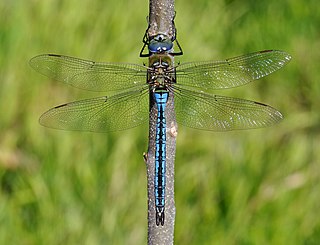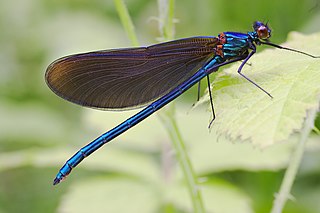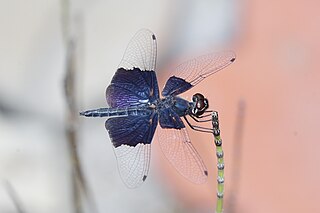
A dragonfly is a flying insect belonging to the infraorder Anisoptera below the order Odonata. About 3,000 extant species of dragonflies are known. Most are tropical, with fewer species in temperate regions. Loss of wetland habitat threatens dragonfly populations around the world. Adult dragonflies are characterised by a pair of large, multifaceted, compound eyes, two pairs of strong, transparent wings, sometimes with coloured patches, and an elongated body. Many dragonflies have brilliant iridescent or metallic colours produced by structural coloration, making them conspicuous in flight. An adult dragonfly's compound eyes have nearly 24,000 ommatidia each.

Damselflies are flying insects of the suborder Zygoptera in the order Odonata. They are similar to dragonflies but are usually smaller and have slimmer bodies. Most species fold the wings along the body when at rest, unlike dragonflies which hold the wings flat and away from the body. Damselflies have existed since the Late Jurassic, and are found on every continent except Antarctica.

The emperor dragonfly or blue emperor is a large species of hawker dragonfly of the family Aeshnidae. It is the bulkiest dragonfly in most of Europe, including the United Kingdom, although exceeded by the magnificent emperor and in length by females of the golden-ringed dragonfly.

The scarlet skimmer or ruddy marsh skimmer, Crocothemis servilia, is a species of dragonfly of the family Libellulidae, native to east and southeast Asia and introduced to Jamaica, Florida, and Hawaii.

The Calopterygidae are a family of damselflies, in the suborder Zygoptera. They are commonly known as the broad-winged damselflies, demoiselles, or jewelwings. These rather large damselflies have wingspans of 50–80 mm, are often metallic-coloured, and can be differentiated from other damselflies by the broader connection between the wings and the body, as opposed to the abrupt narrowing seen in other damselfly families. The family contains some 150 species.

Rhyothemis variegata, known as the common picture wing or variegated flutterer, is a species of dragonfly of the family Libellulidae, found in South Asia.

Anax guttatus, the pale-spotted emperor or lesser green emperor, is a dragonfly of the family Aeshnidae.

The blue riverdamsel, Pseudagrion microcephalum is a common species of damselfly in the family Coenagrionidae. It is also known as the blue sprite and blue grass dart.

Rhyothemis braganza, known as the Iridescent flutterer, is a species of dragonfly in the family Libellulidae. The genus Rhyothemis extends from Africa to the western Pacific, with five species known in Australia. Rhyothemis braganza inhabits streams, rivers and riverine pools on, and adjacent to, the coast in Queensland, Northern Territory and northern Western Australia.

Rhyothemis resplendens, common name Jewel flutterer, is a species of dragonfly in the family Libellulidae. The genus Rhyothemis extends from Africa to the western Pacific, with five species known in Australia. The species Rhyothemis resplendens has blue metallic reflecting panels on both wing sets, and inhabits streams, rivers and still waters on and adjacent to coastal Queensland, from around Mackay to the northern part of Cape York Peninsula. It is a small dragonfly with a wingspan of 40-60mm and body length around 25mm. To the north of Australia it is found in the Moluccas, New Guinea and the Bismarck Archipelago. On the adult, markings on the hindwing are longer than those on the forewing. The taxon has been assessed for the IUCN Red List as being of least concern.

Rhyothemis graphiptera, known as the graphic flutterer or banded flutterer, is a species of dragonfly of the family Libellulidae. It is found across northern Australia, the Moluccas, New Guinea and New Caledonia. Rhyothemis extends from Africa to the western Pacific.

Rhyothemis triangularis is a species of dragonfly in the family Libellulidae. It is widespread in eastern and southern Asia.

Rhyothemis princeps, known as the sapphire flutterer, is a species of dragonfly of the family Libellulidae. The flight of the genus Rhyothemis is usually fluttering, leading to the common description of "flutterer" for most species in the genus.

Agrionoptera insignis is a species of dragonfly in the family Libellulidae. It is native to much of eastern Asia and Oceania, occurring as far north as Japan and as far south as Australia. It is common in most of its range. The circumscription of the species is not entirely clear, so if the species is redescribed, its status may change. Common names include grenadier.

Nannophyopsis is a genus of small-sized dragonflies in the skimmer family Libellulidae. First described by Maurits Lieftinck in 1935, it consists of two species found throughout the Indomalayan biogeographical realm.


















